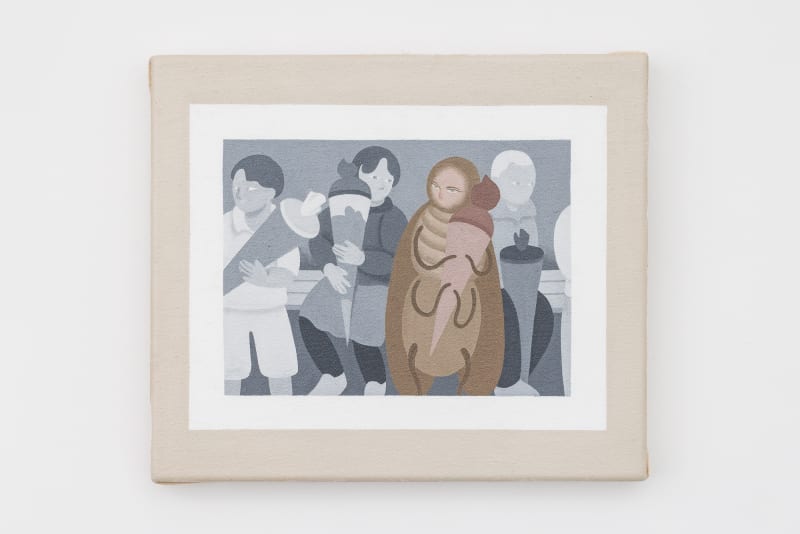The concept of the inner child within the psychological lexicon advocates for an empathy towards a part of our subconscious that has been present since we were conceived, through utero, infant, and childhood formative experiences, the inner child holds emotions and memories which ultimately shape our adult psychological make up. As such, the child within us who we once were, never really leaves us and examining their experiences draws us closer to an authenticity that oftentimes lies out of reach. The work of Alexander Basil contravenes our protectionist mentality by exploring the depths of his own internal psychology with an uncensored honesty that is striking in its vulnerability, in so far as it creates a vexatious reflection on many of our own mental incarcerations.
As with Basil’s wider practice, an interest in personal domesticity and existential examinations of objects and architecture take prevalence in this new body of work. However, within Larvae, instead of depicting objects of the present, for these works Basil muses on items and imagery reflective of his personal history. Woven throughout these depictions, Basil infuses his self-portraiture into the images and the objects themselves. We see a photograph of Basil as a small child on his first day of school holding a Schultüte, a cone filled with presents that German children receive on their first day of school. In others we see the repetitive portrait of the artist turned into gift-wrapping paper, as a stamp and as the fetus within the diagram of an egg designed to inform small children of its composites. Although common in the early 2000s, in contemporary eyes the objects hold a degree of nostalgia for the irregular and ephemeral nature of a pre-digital collage of fragmented memories.
Furthermore, the works within Larvae also hold a preoccupation with the act of seeking an understanding of belonging and identity. From the point of view of comprehending one’s physical existence, several works within the exhibition depict graphics, diagrams and instruction manuals that respectively connote: the beginnings of life within the schematic diagram of an egg, the origin of the human self from cell to infant and directions for survival within an airplane leaflet. The inclusion of these simplistic graphics, originally designed to inform on a basic level, translates to the broader theme of comprehending our physical make up, where we come from and a desire for a logical reasoning behind the elements that create ourselves. In this regard, the simplicity of the graphics, while relating to our formations of knowledge in childhood, work beyond this by encompassing an intrinsic desideratum that follows throughout our lives.
This interest in exploring what composes our identity and existence is a thread that follows through much of Basil’s practice. In this particular exhibition, instead of the elements and iconography of self-creation, the artist places a more considered emphasis on the genetic and familial ties that build up our personal and cultural history. In this regard, Basil explores his own origins in relation to his family as a child from both Russia and Germany with several images of his ancestral tree and analogue family photographs. We see the artist sitting on the lap of his grandfather on the porch outside his grandparent’s dacha near Arkhangelsk in northern Russia where the artist would spend his summers as a child, alongside images of his grandparents and extended cousins.
However, despite the assumption of the idyllic and nostalgic nature of these scenes, Basil subverts this inference with a characteristic focus on a melancholic displacement. This alienation can be read through several manners, in part a relational dislocation from family, cultural disassociation and a childhood estrangement from himself. Throughout the works Basil’s family members are repeatedly depicted in muted grey tones with the self-portraits composed in colour. Furthermore, while his relatives are shown as traditional portraits, Basil is portrayed as an insect or a melted liquid blotch. In this sense, the detached presentation of the young Alexander as an uncomfortable insectile figure lies in stark contrast to the staid images of the other family members. However, there is also a degree of complexity to the estrangement, especially with the sentiment towards the mother. In this vein, within the image where Basil is depicted from an embryo to an infant, the last figure where the baby is no longer attached to the mother through the umbilical cord is the first figure where the artist’s tears appear. Thus, the severing of this connection and the resultant emotion suggests a greater degree of intimate affinity than may first appear on a wider viewing of the works.
Although deeply personal to his own history and childhood experiences, the exhibition leads us to consider with empathy the relationships we have with our families and how they have shaped us. Furthermore, through his capacity for vulnerability, Basil invites us to connect with him and ourselves in the feelings of estrangement and disconnection that are ultimately ubiquitous.

